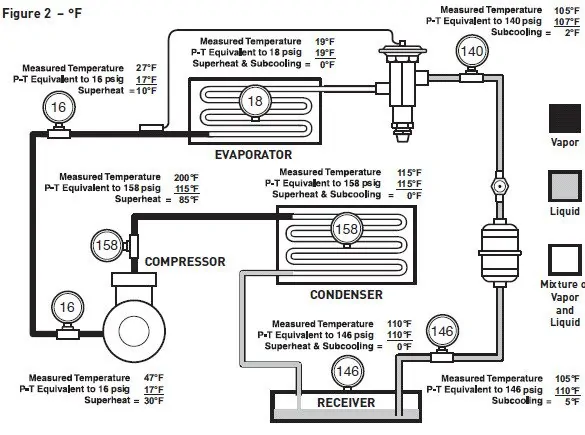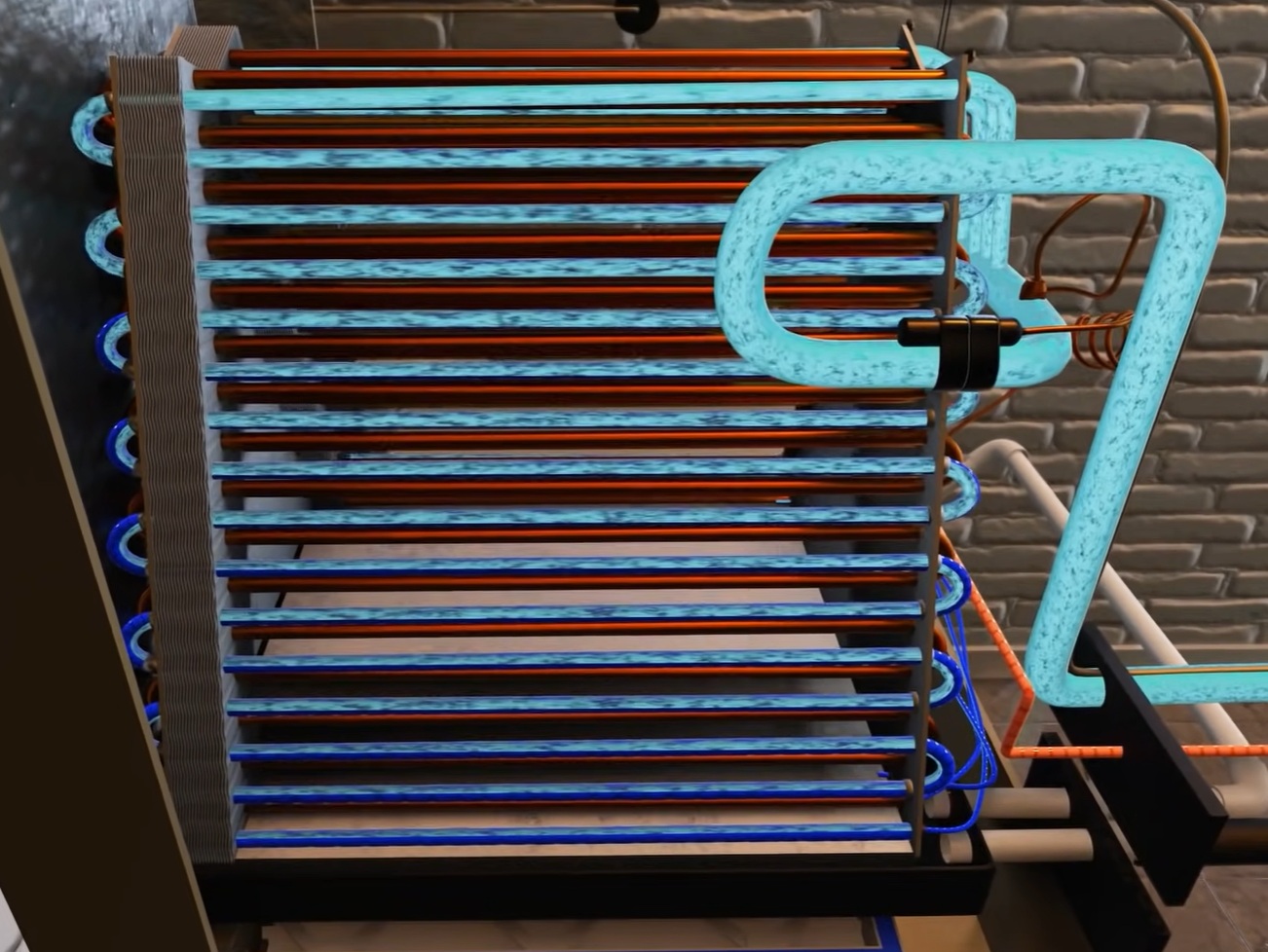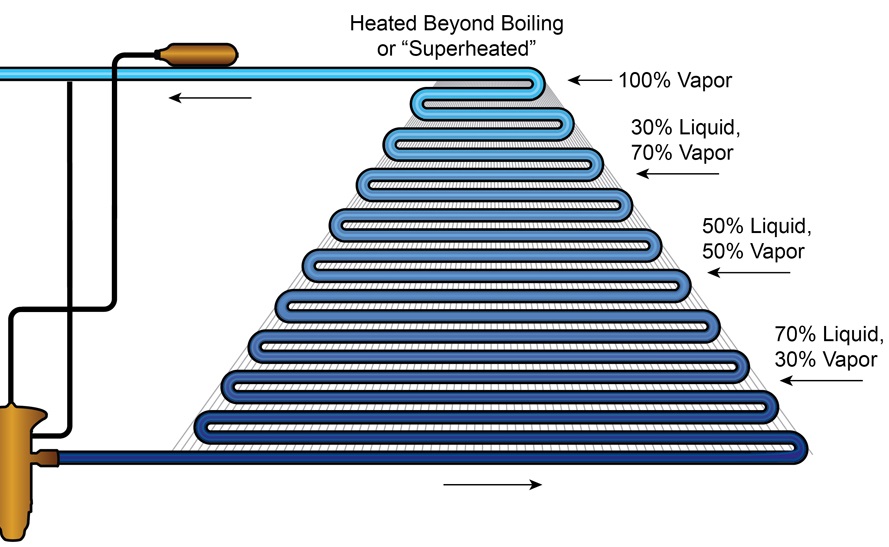Get Tech Tips
Subscribe to free tech tips.
What Should My Superheat Be?

The most common—and often most frustrating—questions that trainers and senior techs get asked sound something like this:
“What should my ______ be?”
or
“My _____ is at ______. Does that sound right?”
Usually, when the conversation is over, both the senior and junior techs walk away feeling frustrated because the junior tech just wanted a quick answer, and the more experienced tech wants them to take all of the proper readings and actually understand the relationships between the different measurements.
This article will explore the “What should my superheat be?” question. If you're wondering about subcooling, we explored that in THIS tech tip.
So, what should the superheat be?
First, what is superheat anyway? It is simply the temperature increase of the refrigerant once it has become fully vaporized. In other words, it is the temperature of a vapor above its boiling (saturation) temperature at a given pressure.
The air around us is all superheated! Head for the hills!
How can you tell that the air around us is all superheated? Because the air all around us is made of vapor. If the air around us were a mixture of liquid air and vapor air, first off, you would be dead, and secondly, the air would be at SATURATION. So, the air around us is well above its boiling temperature (-355°F) at atmospheric pressure, which means it is entirely vapor and SUPERHEATED. In fact, on a 75°F day, the air around you is running a superheat of 430°F.
But why do we care?
We measure superheat (generally) on the suction line exiting the evaporator coil, and it helps us understand a few things.
#1 – It helps ensure we are not flooding the compressor.
First, if we have any reading above 0° of superheat, we can be sure (depending on the accuracy and resolution of your measuring tools) that the suction line is full of completely vapor refrigerant and not a mix of vapor and liquid. That is important because it ensures that we are not running liquid refrigerant into the compressor crankcase. That is called FLOODING and results in compressor lubrication issues over time.

Image courtesy of Parker/Sporlan
#2 – It gives us an indication of how well the evaporator coil is being fed.
When the suction superheat is lower, it tells us that the saturated (boiling) liquid/vapor mixture is feeding FURTHER through the coil. In other words, lower superheat means that saturated refrigerant is feeding a higher % of the coil. When the superheat is higher, we know that the saturated refrigerant is not feeding as far through the coil. In other words, a higher superheat means a lower percentage of the coil is being fed with saturated (boiling) refrigerant.
The higher the % of the coil being fed, the higher the capacity of the system and the higher the efficiency of the coil.

This is why we often “set the charge” using superheat once all other parameters are properly set on a fixed orifice system. Adding refrigerant (on a fixed orifice/piston/cap tube) will feed the coil with more refrigerant, resulting in a lower superheat. Removing refrigerant will increase the superheat by feeding less of the coil with saturated (mixed liquid and vapor) refrigerant.
This method of “setting the charge” by superheat does not work on TXV/TEV/EEV systems because the valve itself controls the superheat. This does not negate the benefit of checking the superheat; it just isn't used to “set the charge.”
#3 – We can ensure our compressor stays cool by measuring superheat.
Most air conditioning compressors are refrigerant-cooled. When the suction gas (vapor) travels down the line and enters the compressor crankcase, it also cools the motor and internal components of the compressor. In order for the compressor to stay cool, the refrigerant must be of sufficient volume (mass flow) and low temperature. Measuring superheat along with suction pressure gives us the confidence that the compressor will be properly cooled. This is one reason why a properly sized metering device, evaporator coil, and load-to-system match must be established to result in an appropriate superheat at the compressor.
#4 – Superheat helps us diagnose the operation of an active metering device (TXV/TEV/EEV).
Most “active” metering devices are designed to output a set superheat (or tight range) at the outlet of the evaporator coil if the valve is provided with a full liquid line of a high enough pressure liquid (often at least 100 PSIG higher than the valve outlet/evaporator pressure). Once we establish that the valve is being fed with a full line of liquid at the appropriate pressure, we check the superheat at the outlet of the evaporator to ensure that the valve is functioning properly or adjusted correctly. If the superheat is too low on a TEV system, we would say the valve is too far open. If it is too high, the valve is too far closed.
#5 – Superheat is an indication of the load on the evaporator.
On both TEV/EEV systems and fixed orifice systems (piston/cap tube), you will notice that when the air (or fluid) going over the evaporator coil has less heat. You will also notice that the suction pressure will drop when there is less airflow (or fluid flow) over the evaporator coil. However, as the heat load on the coil drops on a TEV/EEV system, the valve will respond and shut further, keeping the superheat fairly constant. On a fixed orifice system, the superheat will drop with the load. It can drop so much on a fixed orifice system that the superheat can easily be zero when the system is run outside of design conditions, resulting in compressor flooding.

When the load on the evaporator coil goes up, a TEV/EEV will respond by opening further in an attempt to keep the superheat constant. A fixed metering device cannot adjust. Therefore, as the heat load on the coil goes up, so does the superheat.
When charging a fixed orifice A/C system, you can use the chart below to figure out the proper superheat to set once all other parameters have been accounted for. Alternatively, you can use our special superheat and delta T calculator HERE (top left).

Using this chart requires that you measure indoor (return) wet-bulb temperature so that the heat associated with the moisture in the air is also being accounted for. This is one of MANY target superheat calculators out there; you can use apps, slide rules, etc.
Remember, this chart ONLY applies to fixed orifice systems.
So, what should your superheat be in systems with a TEV/EEV? The best answer is—as usual—whatever the manufacturer says it should be. If you really NEED a general answer, you can generally expect:
- High Temp or A/C systems: 6-14°F
- Medium Temp: 5-10°F
- Low Temp: 4-10°F
- Some ice machines and other specialty refrigeration may be as low as 3°F
When setting the superheat on a refrigeration system with any type of metering device, you often must get the case/space down close to the target temperature before you can make fine superheat adjustments. That is due to the huge swing in evaporator load. Once again, refer to the manufacturer's design specs.
—Bryan











Comments
One hidden gem at Tru Tech Tools that is not on their list at Best Charging Practices page is the Testo Air Conditioning Application Guide which is on another link at their site.
https://trutechguy.com/2011/04/13/testo-ac-applications-guide-2/
One hidden gem at Tru Tech Tools that is not on their list at Best Charging Practices page is the Testo Air Conditioning Application Guide which is on another link at their site.
https://trutechguy.com/2011/04/13/testo-ac-applications-guide-2/
The “another one” link is broken.
Wayne Pendergast has a couple versions of the chart on efficientcomfort.net. He also includes target discharge air temp, and target (rule of thumb) condenser TD based on seer ranges.
I reached out to him a couple of years ago to ask about the origins of the chart, and he said to the best of anyone’s knowledge it was done by Carrier years and years ago. They perfectly charged a system by weight, then ran it in every condition and plotted the results.
Any superheat equation or formula was likely reverse engineered based on the known chart. I’ve found that trying to calculate SH with the equation ((3 x indoor wb) – 80 – ambient) / 2 will get you pretty close around the center part of the chart, but as conditions put you around the edges there is a lot of error.
I’ve also had success using this chart for R-410a systems as well.
The “another one” link is broken.
Wayne Pendergast has a couple versions of the chart on efficientcomfort.net. He also includes target discharge air temp, and target (rule of thumb) condenser TD based on seer ranges.
I reached out to him a couple of years ago to ask about the origins of the chart, and he said to the best of anyone’s knowledge it was done by Carrier years and years ago. They perfectly charged a system by weight, then ran it in every condition and plotted the results.
Any superheat equation or formula was likely reverse engineered based on the known chart. I’ve found that trying to calculate SH with the equation ((3 x indoor wb) – 80 – ambient) / 2 will get you pretty close around the center part of the chart, but as conditions put you around the edges there is a lot of error.
I’ve also had success using this chart for R-410a systems as well.
Bryan, thank you very much for sharing your expertise to the world. This is the FIRST article on SUPERHEAT which made me truly understand what it is! I have read numerous articles on this but I still have so much doubts on this topic such as what refrigerant should have what superheat. But after I have read yours, I am feeling very confident that I have at least understand 99% of superheat. And at this same time, my understanding for subcooling suddenly deepens! Cool! Thanks again. The way you are describing air to refrigerant is just brilliant!!!
Bryan, thank you very much for sharing your expertise to the world. This is the FIRST article on SUPERHEAT which made me truly understand what it is! I have read numerous articles on this but I still have so much doubts on this topic such as what refrigerant should have what superheat. But after I have read yours, I am feeling very confident that I have at least understand 99% of superheat. And at this same time, my understanding for subcooling suddenly deepens! Cool! Thanks again. The way you are describing air to refrigerant is just brilliant!!!
I’ve been told by my boss that the system superheat is supposed to be 20-30 per Copeland. I’ve adjusted the txv on a system I was working on and still couldn’t get more than 19F⁰ of superheat. At around 12F⁰ subcooling.
Is my boss correct?
I’ve been told by my boss that the system superheat is supposed to be 20-30 per Copeland. I’ve adjusted the txv on a system I was working on and still couldn’t get more than 19F⁰ of superheat. At around 12F⁰ subcooling.
Is my boss correct?
Copeland reccomends a minimum of 20 degrees compressor superheat measured on the suction line 6" from the compressor. This is not the same as evaporator superheat your boss may be referring too.
Copeland reccomends a minimum of 20 degrees compressor superheat measured on the suction line 6" from the compressor. This is not the same as evaporator superheat your boss may be referring too.
Hi Adam,
It will depend on the system and metering device. For a TXV anything between 5-20 is pretty normal and I leave it alone. 30 is too high for a TXV but could be perfectly acceptable for a piston system. You will need to calculate target superheat to determine what you are aiming at.
One interesting thing to test is the suction line temp at the evap coil outlet and then at the condenser. I’ve seen up to a 10 degree cooler suction line up in the attic.
Hi Adam,
It will depend on the system and metering device. For a TXV anything between 5-20 is pretty normal and I leave it alone. 30 is too high for a TXV but could be perfectly acceptable for a piston system. You will need to calculate target superheat to determine what you are aiming at.
One interesting thing to test is the suction line temp at the evap coil outlet and then at the condenser. I’ve seen up to a 10 degree cooler suction line up in the attic.
To leave a comment, you need to log in.
Log In